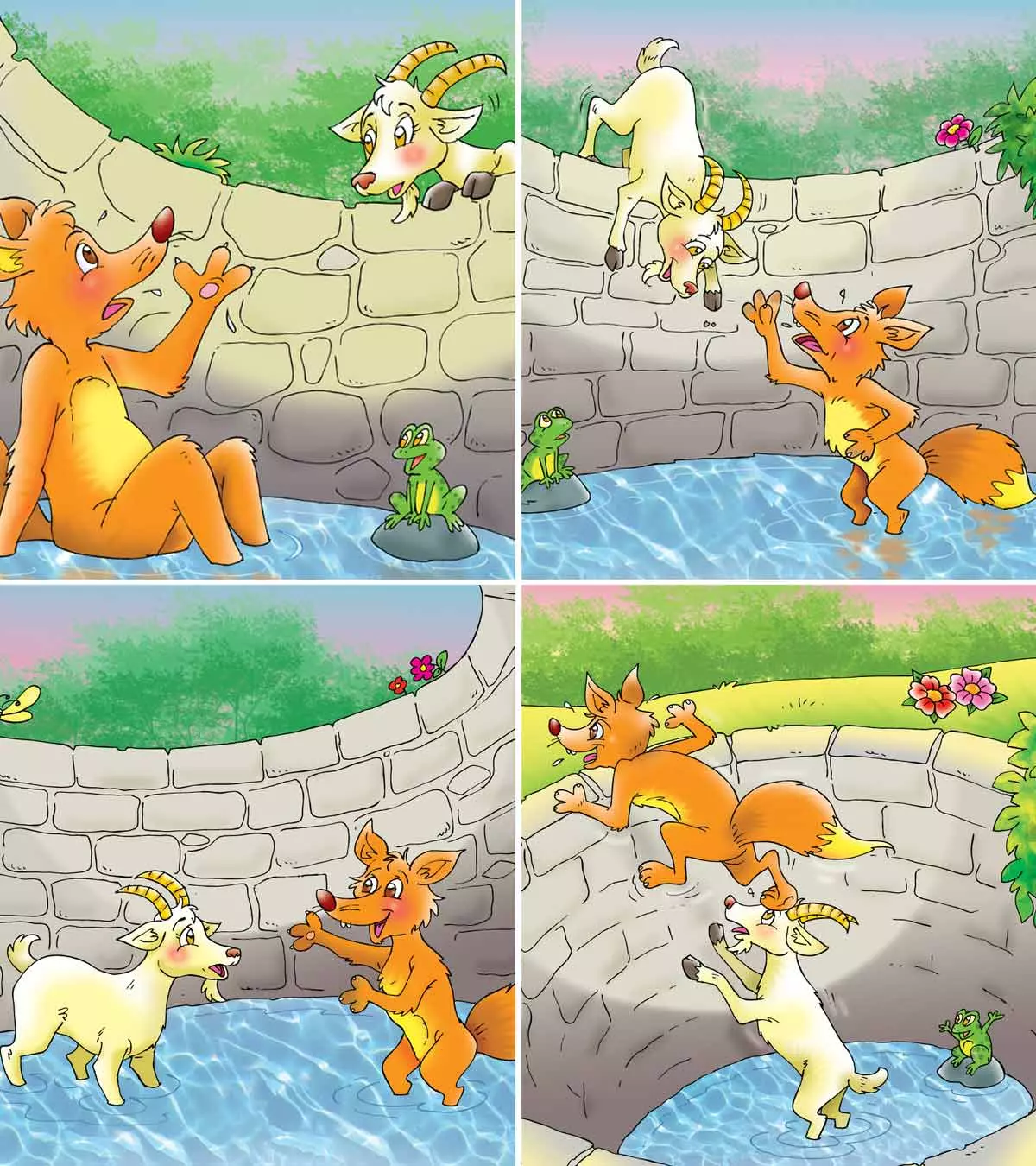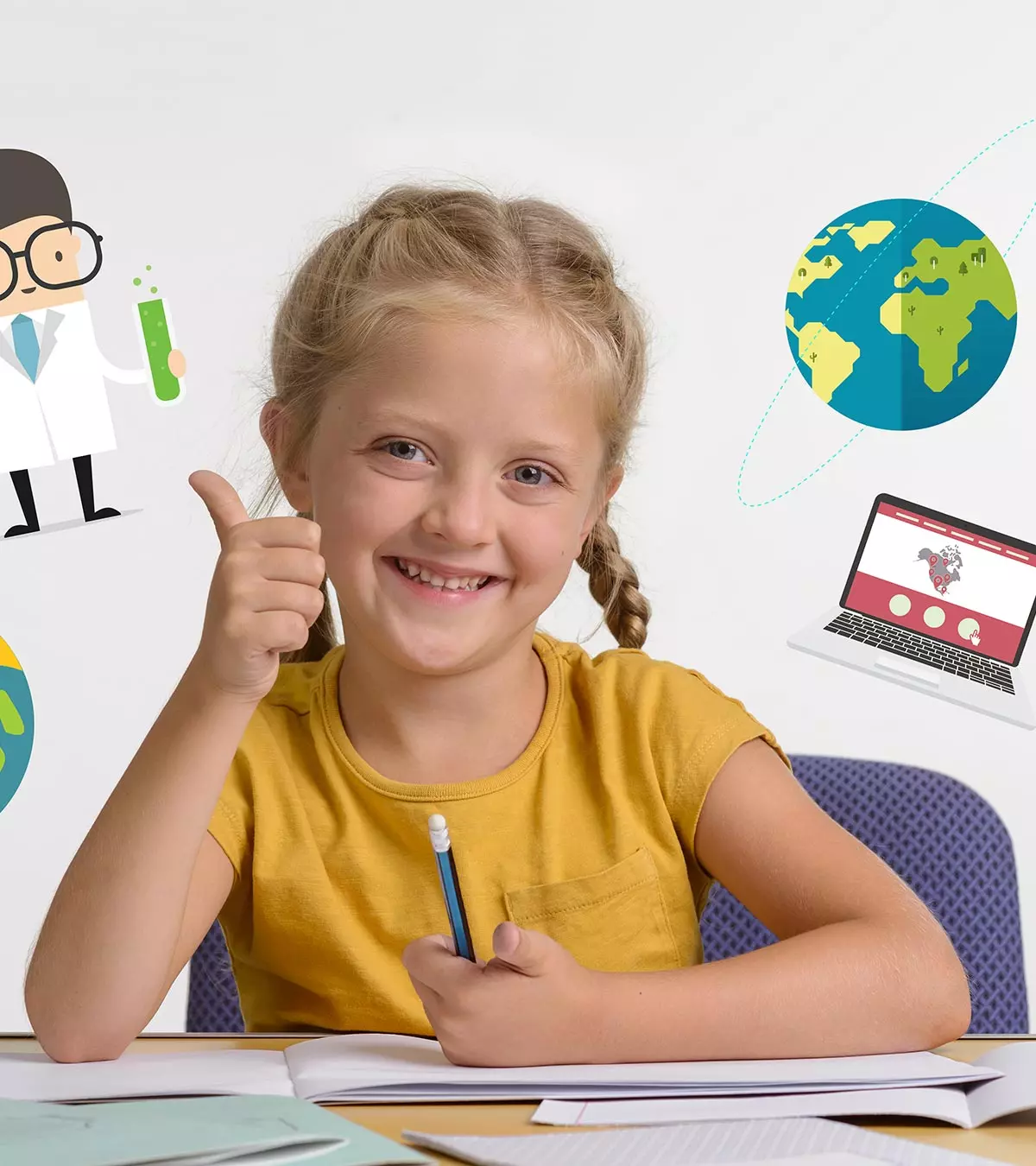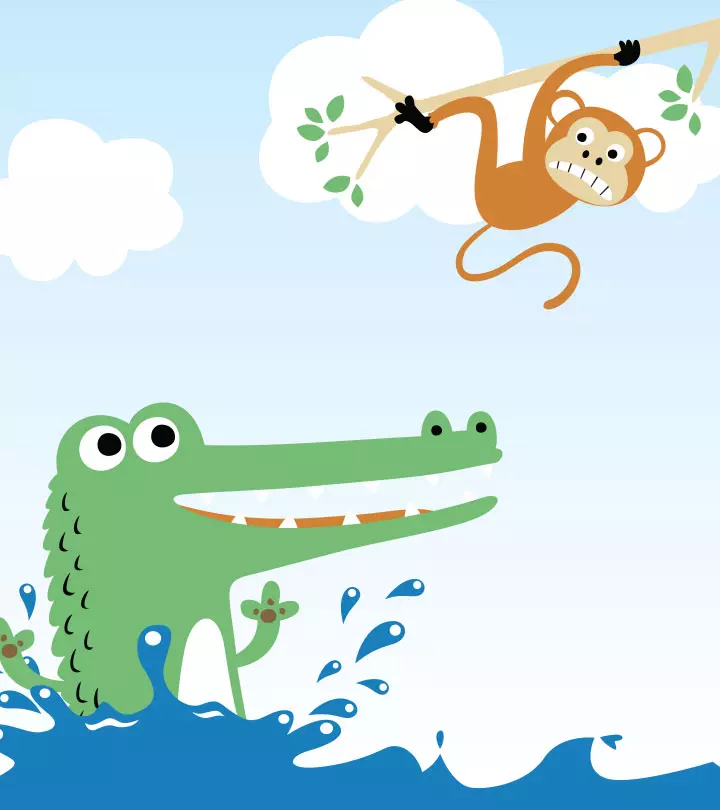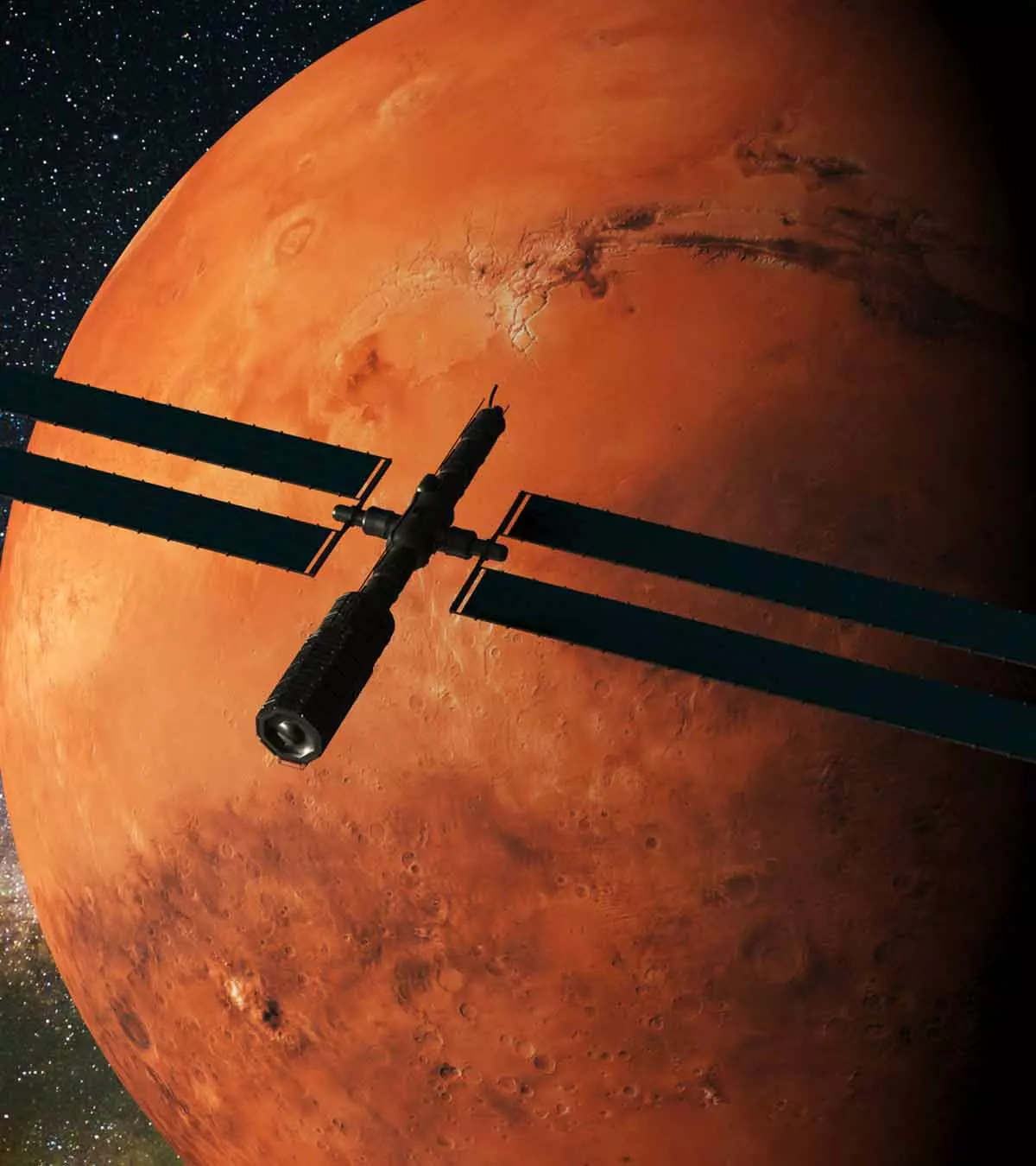
Image: Shutterstock

Although there is a lot of information about Mars on the internet, you may want to know some interesting facts about Mars for kids. Mars is a planet, with a core made of nickel, sulfur, and iron, in the solar system which is often studied to see the possibility of life beyond Earth since its landscape looks like Earth. Galileo first observed the fourth planet through a telescope in 1610 (1). Crediting Mars discovery to one person is difficult since this planet has been observed and studied for more than 4,000 years.
Read on to learn some interesting and fun facts about Mars for kids that may intrigue their curious minds.
Key Pointers
- You can jump three times higher on Mars due to the weakened gravity of the planet compared to the earth.
- Mars is the fourth planet in the solar system, and scientists believe life is possible on it if there is a slight increase in distance from the sun.
- Large amounts of iron oxide make Mars appear red while observing through a telescope. Scroll down for more such facts.
Interesting Mars Facts For Kids
- Jump three times higher: Gravity is weak on this planet, so the force allows a person to jump three times higher than they can jump on the Earth. Wondering how that feels? The movie John Carter, with visuals of a man jumping on Mars, could give you some idea.

Image: Shutterstock
- Day on Mars: This planet takes a longer time to complete one revolution around the Sun. A day on the Red Planet is 24 hours and 37 minutes long – slightly more than a day on our Earth. A year on Mars is 687 Earth days, which is twice the length of a year on Earth!
- First spacecraft on Mars: Viking Landers was the first spacecraft to land on Mars. It touched the planet’s surface in 1976.
 Quick fact
Quick fact- Roman God of war: The naming of Mars has a mythological connection. The planet gets its name from the Roman God of War owing to its fiery red appearance. It is called the Red Planet because of its reddish-brown surface, visible when seen from a distance.
- Fourth planet of the Solar System: Planets are arranged in a magnetic sequence that lets them revolve around the Sun. Earth is in the third position, and then comes Mars in the fourth place. Scientists believe that if the distance between Mars and the Sun decreases slightly, then the possibility of life on Mars will increase.
- Red Planet: Mars appears red when observed through a telescope from the Earth. It gets that color due to a large amount of iron-oxide or rust in its soil and rock. The planet’s color changes to bright red during an eclipse. NASAiAcronym for National Aeronautics and Space Administration, a U.S. government agency involved in aeronautics and space research. official photo catalog includes several outstanding pictures of Mars.
- Second smallest planet in the solar system: With a diameter of 6,791 kilometers, Mars is roughly half the size of Earth. That means it can accommodate only half the Earth’s population should we ever decide to move there!
- Geological history of Mars: According to Space Science Reviews, the geological history of mars is divided into three periods, namely the Noachian Period (4.5 billion years ago), the Hesperian Period (3.3 billion years ago), and the Amazonian Period (2.9 billion years ago). These periods describe the formation of the planet and its geological changes during that time.
- Water on Mars: Water currently exists only in the solid form on Mars. This happens due to its atmospheric pressure, which is 1% less than the Earth (2). The two polar caps are a source of water on the planet, and a huge landscape of frozen CO2 appears in the polar regions.
- Eclipse cycle: Mars experiences partial or annular eclipse. It has two moons, which are small and can only block the Sun partially. NASA’s Curiosity RoveriA space rover (vehicle) developed by NASA to explore the planet Mars. captured photographs of the eclipse on Mars (3). The most amazing one, the “Martian moon Phobos” occurred on March 26, 2019. Sadly, no one can ever view the eclipse from Mars.

Image: Shutterstock
- Climatic conditions on Mars: Due to similar tilts in rotational axes, the seasons of the Earth and Mars could have been similar, but the distance to the Sun and the differences in the planets’ orbits don’t allow it. According to studies, its earliest atmosphere was made up of thick hydrogen molecules, unlike the thin carbon dioxide it has in its atmosphere today.

Image: Shutterstock
- Life on Mars: In 2018, NASA’s Curiosity Rover landed on Mars for the purpose of exploration and discovered life-tracing compounds in sedimentary rocksiRocks formed by sediments of minerals or organic particles. . This sample study changed perspective towards life on Mars. Scientists claim that there’s a possibility that life existed on the surface of Mars billions of years ago. Research and studies about that are in progress. This planet also has many active and inactive artificial satellites planted by different countries.
 Did you know?
Did you know?- Owner of two Moons: Phobos and Deimos are the two moons revolving around the red planet. Both moons are small and remain covered in a dust ring.
- Future on Mars: On July 30, 2025, NASA launched the Perseverance Rover to collect samples on ancient microbial life on the planet. Europe Space Agency (ESA) has plans to launch ExoMars RoveriA joint robotic mission to the planet Mars planned by the European Space Agency and a Russian Space Agency. in 2025. NASA and ESA have a joint project to launch the Mars sample return mission in 2026, which would disclose several secrets about the Red Planet.
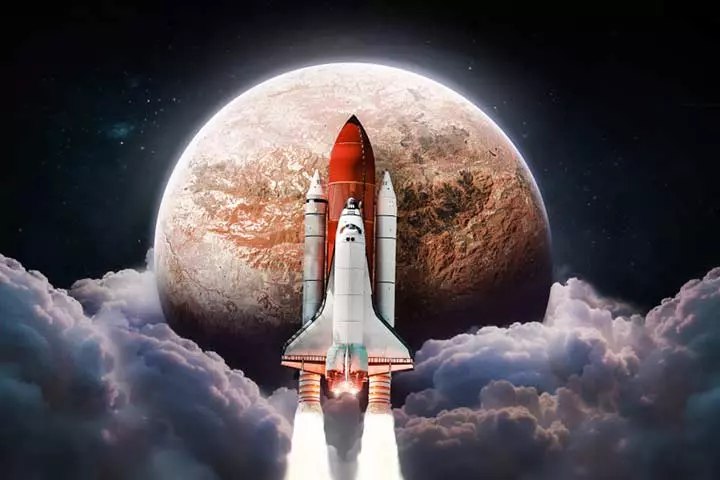
Image: Shutterstock
- Mars and media advertising: Did you know that Hollywood has produced 40+ movies with the Martian concept? The first short film named “A Trip to Mars,” was released in 1910, and after that, humankind never stopped to explore and discover new facts about the planet. John Carter, The Martian, Mission to Mars, Escape from Mars, and The Space Between Us are a few films set on Mars.
- Largest dust storms in the solar system: On a stormy day on Mars, the wind blows at 160 km/hr with iron-oxide dust particles. Mars experiences the largest dust storms in the entire solar system. Storm situations are common there and, at times, cover the complete planet.
- Freezing cold: It is twice as cold as Mount Everest on Mars. Its distance from the Sun makes it a cold planet. The Mars Equator region experiences temperatures around 20°C, but it remains as low as -140°C at the poles. Climatic conditions may change in the next 25,000 years, and maybe the planet will adapt to an atmosphere favorable to life such as one with microbes, plants, animals, and more.

Image: Shutterstock
- Solar system’s highest mountain: Olympus Mons on Mars is the highest peak discovered in the solar system (4). The volcanic mountain is triple the size of Mount Everest and spreads across the Martian land. It is an active volcanic range that might erupt in the future, perhaps after a few million years.
- Red Planet meteors: Asteroid and Meteor showers on Earth are a natural phenomenon. Sometimes, these asteroids first hit Mars’ surface and later get diverted towards Earth. Debris from such asteroids and meteor showers is scattered across the planet. Thus, its surface features several craters.
- Introducing Martians: While we have found no evidence of life on Mars, let alone aliens or human-like species, we have a name ready for the inhabitants of Mars – Martians. The Martian term came from Hollywood, where the alien characters bring the magic of space to the big screen.
These simple facts are enough to pique the child’s curiosity about the Red Planet. Read on as we list some more cool facts about Mars.
All the planets in our Solar System have different gravitational forces. The graph below depicts all the planets and their forces of gravity. From the chart, it is clear that Jupiter has a force more than six times that of Mars and more than twice that of the Earth. On the other hand, Pluto, which was considered a planet until 2006, has the lowest force of gravity.

Gravity of different planets
Source: Planets gravity; TuTortugasCool Mars Fun Facts for Kids
- Mars-One is the dream project of scientists to colonize the Red Planet by the year 2025.
- Earth can fit in six Mars planets in terms of volume. Mars is extremely small when compared to the Sun. If the Sun were a typical front door, Mars would be the size of aspirin (5).
- Scientists have found rock samples of Mars’ surface on the Earth.
- Mars is perhaps the most popular planet of the solar system that captured International media attention.
- It is the closest terrestrial planet next to Earth.
- The average distance from Earth to Mars is 225 million km / 140 million miles.
Frequently Asked Questions
1. How old is Mars?
The red planet was formed almost the same time the other solar system planets formed. It is believed that Mars could be 4.6 billion years old (6).
2. Why does Mars lose water?
Once upon a time, Mars was filled with water with vast water bodies like pools, lakes, and oceans. Currently, there is little water on the planet. The professionals at CaltechiCalifornia Institute of Technology, a renowned science and engineering institution in the world. estimate that Mars lost its water partly to the atmosphere. The remaining became a part of the planet’s crust (7).
3. What are the educational benefits of teaching facts about Mars to children?
Teaching facts about Mars to kids expands their knowledge about space, planets, and our universe. It sparks their curiosity, encourages scientific thinking, and promotes an understanding of the world beyond Earth, inspiring future exploration and learning.
4. What resources are available to help teach kids about Mars?
Numerous online and offline resources exist to educate children about Mars. For instance, NASA’s website offers dedicated sections with educational materials, engaging videos, and interactive tools, providing a wealth of information about the Red Planet. Additionally, space-themed children’s books, movies, and instructional YouTube channels offer exciting ways to learn about this intriguing planet. Visiting local planetariums, museums, and science workshops are other ways to acquaint children with the Crimson planet.
5. What are the risks of teaching facts about Mars to kids that are not accurate?
Sharing inaccurate facts about Mars or any subject can lead to misconceptions and incorrect assumptions about planetary and space science. It can also hinder scientific literacy and stifle a child’s interest and curiosity in the subject. Above all, once a child has internalized inaccurate information, unlearning and re-learning can be highly challenging.
6. What sort of activities can be done to make teaching facts about Mars for kids fun and engaging?
Making artwork inspired by Mars, building model rovers, indulging in easy experiments related to Martian conditions, watching videos about Mars, and using interactive apps or games that simulate Mars exploration are some activities to make teaching facts about Mars more fun, engaging, and interactive.
These fascinating facts about Mars for kids will make them interested in astronomy and learning more about our universe. In that case, you may introduce them to facts about the solar system. Planets are fascinating, especially our neighboring planet, Mars. Also known as the Red Planet, Mars gets its name from the Roman god of war, owing to its reddish hue, which may be associated with bloodshed. There is evidence of water on Mars, and NASA’s Curiosity rover, which landed on the planet in 2018, also discovered life-tracing compounds on the planet. Share these and other hair-raising facts about Mars with your child and quench their curiosity.
Mars is the fourth planet in our Solar system. There have been many Mars missions in recent years, leading to the discovery of water and life-supporting compounds on the planet. Check out the infographic below to learn interesting facts about Mars you can share with your children to pique their curiosity about outer space.
Some thing wrong with infographic shortcode. please verify shortcode syntaxIllustration: Fun And Interesting Facts About Mars For Kids

Image: Stable Diffusion/MomJunction Design Team
Explore the fascinating world of Mars in this interesting video. Learn all about living on the Red Planet and the possibilities of a future Mars colony.
References
- All About Mars; Nasa.gov
https://spaceplace.nasa.gov/all-about-mars/en/#:~:text=Mars%20is%20sometimes%20called%20the - Water on Mars? University of California
https://earthguide.ucsd.edu/virtualmuseum/virtualmuseum/WateronMars.shtml - Curiosity Captured Two Solar Eclipses on Mars; Nasa.gov
https://www.jpl.nasa.gov/news/curiosity-captured-two-solar-eclipses-on-mars// - Volcanoes: Olympus Mons 1998; Nasa.gov
https://science.nasa.gov/solar-system/resources/resource-packages/mars-resources/ - The Mars Planet; Nasa.gov
https://science.nasa.gov/mars/ - How old is Mars?
https://coolcosmos.ipac.caltech.edu/ask/88-How-old-is-Mars- - What happened to Mars’s water? It is still trapped there;
https://www.caltech.edu/about/news/what-happened-to-marss-water-it-is-still-trapped-there - OLYMPUS MONS
https://science.nasa.gov/solar-system/resources/resource-packages/mars-resources/
Community Experiences
Join the conversation and become a part of our nurturing community! Share your stories, experiences, and insights to connect with fellow parents.
Read full bio of Theresa Bertuzzi
Read full bio of Bharathi V
Read full bio of Harshita Makvana
Read full bio of Kavita Kankani








